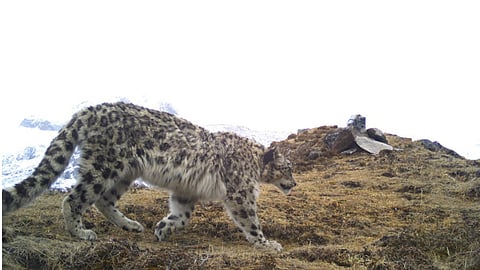
- Home
- Live Blog
- Breaking News
- Top Headlines
- Cities
- NE News
- Sentinel Media
- Sports
- Education
- Jobs

ARUNACHAL PRADESH: In the landmark Snow Leopard Population Assessment in India (SPAI) report, Arunachal Pradesh emerges as the number one in the Northeast, with the highest density of snow leopards in the region. The study from 2019 to 2023 involved a concerted effort to estimate and understand the elusive snowy owl populations that are critical to their conservation.
The challenging task of setting up camera traps in high-altitude regions, where snow leopards are typically found beyond 3000 meters, demands not only technical skills but also physical strength and endurance. Rishi Kumar Sharma, Lead Snow Leopard Program at WWF India, emphasizes the difficulties, citing temperatures dropping below -10 degrees and rapidly depleting oxygen levels at altitudes ranging from 3000 to 5600 meters.
Total of 241 unique snow leopards were photographed during the SPAI exercise, with Arunachal Pradesh contributing 8 and Sikkim 14 to the count. Arunachal Pradesh, with an estimated population of 36, and Sikkim, with 21, play a significant role in India's overall snow leopard population of 718.
The difficult terrain of Arunachal Pradesh made work difficult, requiring individuals to walk 10-20 km, low oxygen levels added challenges SPAI planned to cover more than 70% of potential snow leopards in the state, with humans types such as forestry and wildlife personnel, researchers and volunteers are included.
Ladakh takes the lead with the highest snow leopard population at 477, followed by Uttarakhand (124), Himachal Pradesh (51), Arunachal Pradesh (36), Sikkim (21), and Jammu and Kashmir (9). The report highlights the need for a dedicated Snow Leopard Cell at the Wildlife Institute of India under the Ministry of Environment, Forest and Climate Change (MoEFCC) for long-term population monitoring.
The SPAI program has made a significant effort, including 13,450 kilometers of surveyed roads, 1,971 cameras and 180,000 trap nights The report recommends periodic population estimates, with states and union territories will recognize research every four years as essential to effective conservation strategies Its longevity ensures that snow leopards. This comprehensive study not only sheds light on snow leopard population distribution, but highlights the importance of ongoing monitoring and focused conservation efforts to create these majestic creatures this protection in the face of environmental challenges is also emphasized.
ALSO READ: Assam: Minor Boy Arrested For Alleged Rape And Murder Of 6-Year-Old In Barpeta
ALSO WATCH: